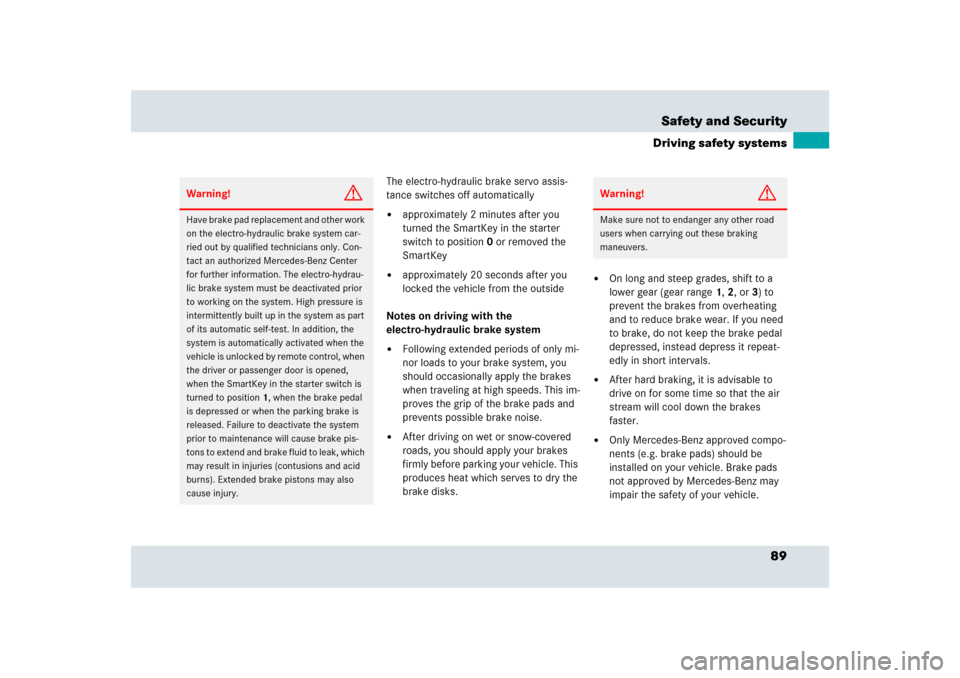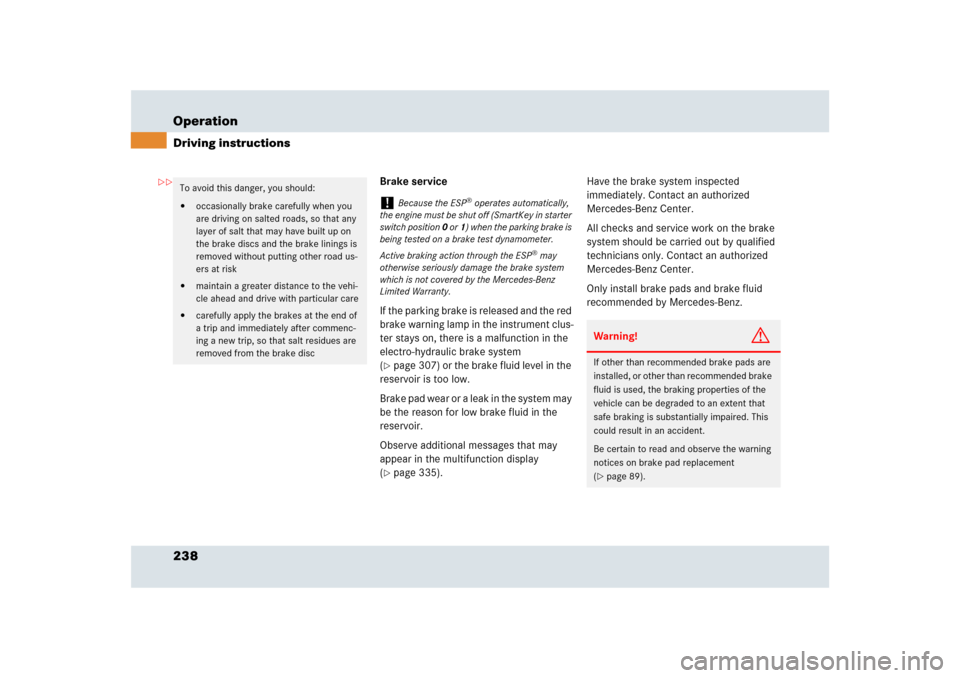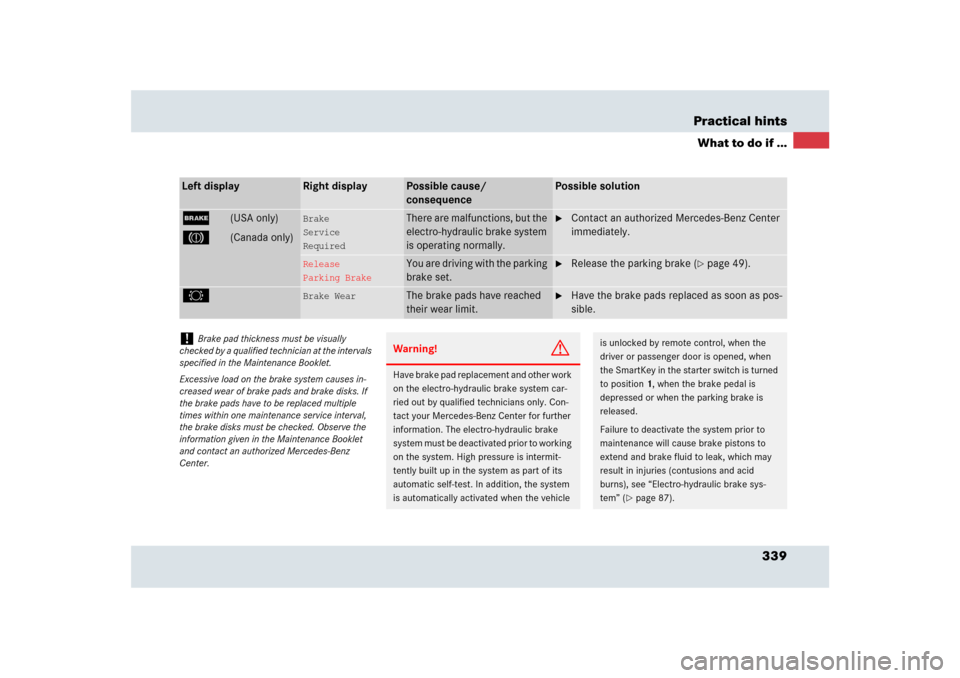Page 89 of 426

89 Safety and Security
Driving safety systems
The electro-hydraulic brake servo assis-
tance switches off automatically�
approximately 2 minutes after you
turned the SmartKey in the starter
switch to position0 or removed the
SmartKey
�
approximately 20 seconds after you
locked the vehicle from the outside
Notes on driving with the
electro-hydraulic brake system
�
Following extended periods of only mi-
nor loads to your brake system, you
should occasionally apply the brakes
when traveling at high speeds. This im-
proves the grip of the brake pads and
prevents possible brake noise.
�
After driving on wet or snow-covered
roads, you should apply your brakes
firmly before parking your vehicle. This
produces heat which serves to dry the
brake disks.
�
On long and steep grades, shift to a
lower gear (gear range1, 2, or 3) to
prevent the brakes from overheating
and to reduce brake wear. If you need
to brake, do not keep the brake pedal
depressed, instead depress it repeat-
edly in short intervals.
�
After hard braking, it is advisable to
drive on for some time so that the air
stream will cool down the brakes
faster.
�
Only Mercedes-Benz approved compo-
nents (e.g. brake pads) should be
installed on your vehicle. Brake pads
not approved by Mercedes-Benz may
impair the safety of your vehicle.
Warning!
G
Have brake pad replacement and other work
on the electro-hydraulic brake system car-
ried out by qualified technicians only. Con-
tact an authorized Mercedes-Benz Center
for further information. The electro-hydrau-
lic brake system must be deactivated prior
to working on the system. High pressure is
intermittently built up in the system as part
of its automatic self-test. In addition, the
system is automatically activated when the
vehicle is unlocked by remote control, when
the driver or passenger door is opened,
when the SmartKey in the starter switch is
turned to position1, when the brake pedal
is depressed or when the parking brake is
released. Failure to deactivate the system
prior to maintenance will cause brake pis-
tons to extend and brake fluid to leak, which
may result in injuries (contusions and acid
burns). Extended brake pistons may also
cause injury.
Warning!
G
Make sure not to endanger any other road
users when carrying out these braking
maneuvers.
Page 238 of 426

238 OperationDriving instructions
Brake service
If the parking brake is released and the red
brake warning lamp in the instrument clus-
ter stays on, there is a malfunction in the
electro-hydraulic brake system
(�page 307) or the brake fluid level in the
reservoir is too low.
Brake pad wear or a leak in the system may
be the reason for low brake fluid in the
reservoir.
Observe additional messages that may
appear in the multifunction display
(�page 335).Have the brake system inspected
immediately. Contact an authorized
Mercedes-Benz Center.
All checks and service work on the brake
system should be carried out by qualified
technicians only. Contact an authorized
Mercedes-Benz Center.
Only install brake pads and brake fluid
recommended by Mercedes-Benz.
To avoid this danger, you should:�
occasionally brake carefully when you
are driving on salted roads, so that any
layer of salt that may have built up on
the brake discs and the brake linings is
removed without putting other road us-
ers at risk
�
maintain a greater distance to the vehi-
cle ahead and drive with particular care
�
carefully apply the brakes at the end of
a trip and immediately after commenc-
ing a new trip, so that salt residues are
removed from the brake disc
!
Because the ESP
® operates automatically,
the engine must be shut off (SmartKey in starter
switch position 0 or1) when the parking brake is
being tested on a brake test dynamometer.
Active braking action through the ESP
® may
otherwise seriously damage the brake system
which is not covered by the Mercedes-Benz
Limited Warranty.
Warning!
G
If other than recommended brake pads are
installed, or other than recommended brake
fluid is used, the braking properties of the
vehicle can be degraded to an extent that
safe braking is substantially impaired. This
could result in an accident.
Be certain to read and observe the warning
notices on brake pad replacement
(�page 89).
��
Page 339 of 426

339 Practical hints
What to do if ...
Left display
Right display
Possible cause/
consequence
Possible solution
;
(USA only)
3
(Canada only)
Brake
Service
Required
There are malfunctions, but the
electro-hydraulic brake system
is operating normally.
�
Contact an authorized Mercedes-Benz Center
immediately.
Release
Parking Brake
You are driving with the parking
brake set.
�
Release the parking brake (
�page 49).
2
Brake Wear
The brake pads have reached
their wear limit.
�
Have the brake pads replaced as soon as pos-
sible.
!
Brake pad thickness must be visually
checked by a qualified technician at the intervals
specified in the Maintenance Booklet.
Excessive load on the brake system causes in-
creased wear of brake pads and brake disks. If
the brake pads have to be replaced multiple
times within one maintenance service interval,
the brake disks must be checked. Observe the
information given in the Maintenance Booklet
and contact an authorized Mercedes-Benz
Center.
Warning!
G
Have brake pad replacement and other work
on the electro-hydraulic brake system car-
ried out by qualified technicians only. Con-
tact your Mercedes-Benz Center for further
information. The electro-hydraulic brake
system must be deactivated prior to working
on the system. High pressure is intermit-
tently built up in the system as part of its
automatic self-test. In addition, the system
is automatically activated when the vehicle
is unlocked by remote control, when the
driver or passenger door is opened, when
the SmartKey in the starter switch is turned
to position1, when the brake pedal is
depressed or when the parking brake is
released.
Failure to deactivate the system prior to
maintenance will cause brake pistons to
extend and brake fluid to leak, which may
result in injuries (contusions and acid
burns), see “Electro-hydraulic brake sys-
tem” (
�page 87).